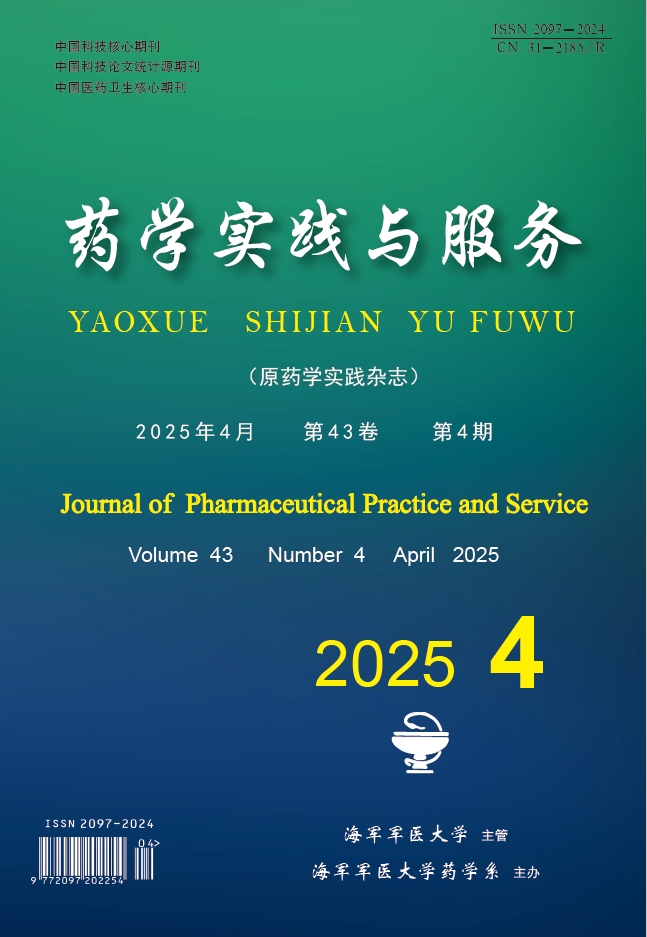2023 Vol. 41, No. 7
Display Method:
2023, 41(7): 393-395, 432.
doi: 10.12206/j.issn.2097-2024.202202050
Abstract:
With the increasing proportion of Candida glabrata in patients with candidiasis, C. glabrata has become one of the most common pathogenic Candida in clinical practice. There are limited types of antifungal drugs, and the consequent problem of drug re...
With the increasing proportion of Candida glabrata in patients with candidiasis, C. glabrata has become one of the most common pathogenic Candida in clinical practice. There are limited types of antifungal drugs, and the consequent problem of drug re...
2023, 41(7): 396-399, 407.
doi: 10.12206/j.issn.2097-2024.202211056
Abstract:
Gynecological inflammatory disease refers to female reproductive system inflammatory disease, which has a direct impact on the female conception and reproductive health. Kangfuyan capsule is a classic traditional Chinese medicine preparation of the M...
Gynecological inflammatory disease refers to female reproductive system inflammatory disease, which has a direct impact on the female conception and reproductive health. Kangfuyan capsule is a classic traditional Chinese medicine preparation of the M...
2023, 41(7): 400-402, 427.
doi: 10.12206/j.issn.2097-2024.202108100
Abstract:
The antimicrobial peptide Epinecidin-1 is a kind of small molecule active peptides extracted from Epinephelus coioides, which serves as the first line of defense for innate immune defense system of Epinephelus coioides against various pathogens. In v...
The antimicrobial peptide Epinecidin-1 is a kind of small molecule active peptides extracted from Epinephelus coioides, which serves as the first line of defense for innate immune defense system of Epinephelus coioides against various pathogens. In v...
2023, 41(7): 403-407.
doi: 10.12206/j.issn.2097-2024.202207035
Abstract:
Functional peptides refer to peptides that are beneficial to life activities or have special physiological activities, also known as bioactive peptides. Oyster is rich in protein and is a good material for developing bioactive peptides, which has gre...
Functional peptides refer to peptides that are beneficial to life activities or have special physiological activities, also known as bioactive peptides. Oyster is rich in protein and is a good material for developing bioactive peptides, which has gre...
2023, 41(7): 408-410, 448.
doi: 10.12206/j.issn.2097-2024.202106033
Abstract:
As the "star product" of Shanghai, Shanghai herbal paste has played an irreplaceable role both in the treatment of diseases and nurturing health. The concept of Shanghai regional culture, Shanghai style Chinese medicine and Shanghai herbal paste were...
As the "star product" of Shanghai, Shanghai herbal paste has played an irreplaceable role both in the treatment of diseases and nurturing health. The concept of Shanghai regional culture, Shanghai style Chinese medicine and Shanghai herbal paste were...
2023, 41(7): 411-415, 442.
doi: 10.12206/j.issn.2097-2024.202208068
Abstract:
Objective To isolate the secondary metabolites of endophytic fungus Aspergillus sp. J218 from Anectochilus roxburhii. Methods D ifferent chromatographic methods, including Sephadex LH-20 and silica gel chromatography as well as HPLC, were used to ...
2023, 41(7): 416-421, 436.
doi: 10.12206/j.issn.2097-2024.202209084
Abstract:
Objective To explore the pharmacokinetic properties of curcumin nano emulsion and its pharmacodynamic effects on hyperlipidemia in rats. Methods T he method for determination of curcumin was established by HPLC-MS. The pharmacokinetics characteris...
2023, 41(7): 422-427.
doi: 10.12206/j.issn.2097-2024.202106092
Abstract:
Objective To establish a quality control method for detecting impurities in chloral hydrate raw materials, improve the quality standards and control limits of raw materials. Methods The determination methods of chloroform and halogenated carbo...
2023, 41(7): 428-432.
doi: 10.12206/j.issn.2097-2024.202207112
Abstract:
Objective To establish the Good Agricultural Practice(GAP)for standard operation procedure of Shanghai Pheretima. Methods A ccording to the comprehensive technical requirements of GAP standardized production of Chinese herbal medicine, the key tec...
2023, 41(7): 433-436.
doi: 10.12206/j.issn.2097-2024.202111002
Abstract:
Objective To perform microscopic identification for the roots of Actinidia macrosperma C.F. Liang, Actinidia valvata Dunn, Actinidia arguta (Sieb. & Zucc) Planch. ex Miq., Actinidia chinensis Planch., and provide the basis for judging medicinal mate...
2023, 41(7): 437-442.
doi: 10.12206/j.issn.2097-2024.202108038
Abstract:
Objective To study the curative effects of traditional Chinese medicine paste combined with Baduanjin in treatment of osteoporotic vertebral compression fracture (OVCF) after percutaneous vertebroplasty (PVP). Methods 120 OVCF patients treate...
2023, 41(7): 443-448.
doi: 10.12206/j.issn.2097-2024.202111080
Abstract:
Objective To evaluate the efficacy and safety of Ilaprazole Enteric-Coated Tablets in the treatment of RE. Methods The databases of CNKI, VIP, Wanfang Data, PubMed, Embase, and The Cochrane Library were searched to collect all the randomized c...
2023, 41(7): 449-454.
doi: 10.12206/j.issn.2097-2024.202203089
Abstract:
Objective To evaluate the efficacy and safety of bimekizumab in the treatment of moderate/severe plaque psoriasis. Methods Literatures from Cochrane Library, PubMed, Embase, CNKI, VIP databases from the establishment time to January of 2022 we...




 Contribution System
Contribution System Author Login
Author Login Review Login
Review Login Editor Login
Editor Login Reader Login
Reader Login



 News
News